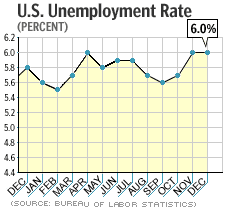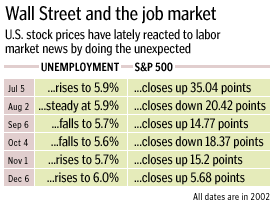NEW YORK (CNN/Money) -
On its face, Friday's U.S. unemployment report looked flat-out horrible, with the jobless rate stuck in the mud and more than 100,000 jobs slashed from payrolls -- but many economists said things weren't all that bad, and U.S. markets seemed to believe them.
The unemployment rate stayed at 6 percent in December 2002, the Labor Department said, matching November's rate ... and April's rate ... and the August 1994 rate, the last time unemployment was so bad.
Meanwhile, a hoped-for recovery in retail hiring never materialized -- that sector shed 104,000 jobs, trumping even the manufacturing sector, which saw payrolls shrink for the 29th straight month. All together, non-farm payrolls shed 101,000 jobs in December, the worst month since February 2002.

Sounds awful, and markets reacted as expected, falling in early trading.
But a funny thing happened on the way to despair -- economists started pointing out silver linings in the report, and markets suddenly turned positive. Though they were mixed in later trading, they never sank back to their earlier levels.
"People are becoming more accepting of a slow, gradual recovery, whereas last year, they had great growth numbers in mind, and when that didn't pan out, markets got hit hard," said James Padinha, economic strategist at Arnhold & S. Bleichroeder. "As long as data don't indicate a new round of fundamental economic deterioration, we're still on the same growth track."
And many economists doubted Friday's report did signal the end of the world for the economy -- though they admit that uncertainty about problems in Iraq and North Korea, along with a glut of production capacity, sluggish profits and other woes -- could keep the labor market on ice for much of 2003.
For one thing, the unemployment rate stayed steady, and 100,000 jobs is really not that significant, statistically speaking -- some economists noted on Thursday that the margin of error for their estimates was about 100,000 jobs.

More importantly, data about the labor market get sort of freaky around the holidays, as the Labor Department tries to make seasonal adjustments to account for the hiring and firing of temporary workers -- so the data are not totally reliable.
The Labor Department also makes seasonal adjustments in January and February to account for all the pink slips given to mall Santas and other temporary help. This year, however, fewer mall Santas were hired, so fewer will be fired, and January and February's data could look even better than expected.
"[Excluding seasonal adjustments] retail employment was actually up in December, but the seasonal factors expected much more. That was especially true in the restaurant sector," John Silvia, chief economist at Wachovia Securities, wrote in a research note. "Watch out next month when the seasonals reverse!"
Another 'jobless recovery'
While 100,000 job cuts may be statistically insignificant, try telling that to the 100,000 people who lost their jobs, joining the ranks of the 8.6 million people unemployed in December, 3.2 million of whom have been out of work for 15 weeks or more.
President Bush and Congress are understandably nervous about this large group of disgruntled potential voters -- at the president's urging, the 108th Congress passed an extension of unemployment benefits in its first session on Monday.
The president almost certainly remembers the lesson of his father, who lost a re-election bid in 1992 because of a lousy job market and accusations he was unconcerned about it.
In fact, Bush's "jobless recovery" is eerily reminiscent of his father's, at least in one respect. During the 12 months that followed the 1990-91 recession, when Bush's father was president, employers cut an average of 17,580 jobs monthly. During the 12 months after the end of the 2001 recession -- assuming a new expansion started after December 2002 -- non-farm employers cut an average of 15,080 jobs per month.
With such scary figures in mind, Bush has proposed an ambitious, $674 billion plan of tax cuts and spending that he says will grow 2.1 million jobs in the next three years.
"The president remains very concerned about the potential for a jobless recovery," White House spokesman Ari Fleischer told reporters. "And this is why he calls on Congress to act as quickly as Congress can to pass a job-creating initiative that stimulates the economy and provides greater growth not only for this year, but into the future."
But, according to the New York Times, the White House has admitted that only about 190,000 of those 2.1 million jobs it thinks its plan will create will come in 2003 -- just making up for the job losses in November and December 2002.
And while Congress acted quickly to extend unemployment benefits, a no-brainer of an issue, it's likely to take a lot more time to sort out the particulars of the Bush plan, which is dramatically different from the alternative proposed by Democrats and includes a controversial idea to eliminate the tax people pay on stock dividends.
"My problem with the Bush plan is that it's so ideologically problematic that now these guys are going to have to argue about it for a month or two," Jared Bernstein, labor economist with the Economic Policy Institute, told CNNfn's CNNmoney Morning program. "That's bad because we need to inject stimulus into the economy quickly."
Iraq concerns weigh on labor market
But many economists point out that, with the tax cut Congress passed in 2001 and a Federal Reserve that has slashed its target for short-term interest rates to levels not seen since the Kennedy administration, there's already plenty of stimulus in the pipeline.
The biggest reason nobody can get a job, some economists believe, is uncertainty about whether or not the United States will go to war in Iraq -- the same "geopolitical uncertainties" the Fed talked about late last year when cutting rates.
"The real problem here is business confidence, or the lack of it, and it stems primarily from a sense of major uncertainty," said Anirvan Banerji, research director for the Economic Cycle Research Institute. "Geopolitical uncertainty makes businesses unsure of whether or not we can have a sustainable recovery. Are they willing to stick their necks out and hire people and invest in equipment? Their answer has been, 'No.'"
Another factor throwing a wet blanket on spending and hiring is an excess of production capacity left over after a glut of spending in the late 1990s. Factories are using less than 75 percent of their capacity, according to recent Fed data.
Meanwhile, sluggish corporate profit growth has led to massive cost-cutting, and labor is a pretty fungible cost. Businesses have found they can milk more work out of fewer workers, leading to massive productivity gains that support profits and keep consumer prices low, but don't offer much incentive for businesses to hire more workers.
With all this in mind, only the most optimistic economists think the labor market will noticeably improve by the spring of this year. Many other estimates expect the weakness to linger well into 2003.
"We're not only stuck in a soft patch; we're spinning our wheels," said Bill Cheney, chief economist at John Hancock Financial Services. "To get back to full employment, we need a lot more demand, and that's hard to see coming anytime soon from either domestic or international sources."

|

